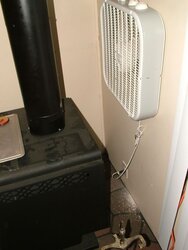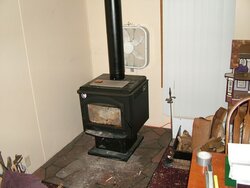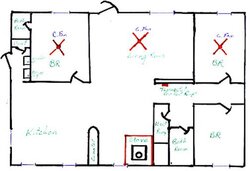jayte said:
Thank you very much for the ideas. A couple of things I could smack myself for not coming up with. I had not considered timers or coming in from an angle across the top. Right now I had settled in using the box fan about 6 feet or so in front blowing cool are toward the stove and it has given me my best results. I have also contiplaited putting in another ceiling fan in that area. The Stanley blower makes me a little nervous because from what I have seen when I look it up on the internet.... it appears that its size will put its plastic body within the clearance for the stove.... I know it is cool to touch down there but I'm still a good lemming and afraid to step on the rules. When I return home this week I visit our ace hardware and measure. We have had spring like weather the last few days and so have not needed much and my wife tells me it has been very comfortable.
Only 5 minutes or so on the timer. I really anxious to try the timing thing.... I hate running the fan all night. What would you think of one of those convection fans that you can put on top of the stove in place of an angled floor fan... to swirl the air above the stove? Thanks again for the ideas.
Understand your reticence about placing anything low and behind the stove, especially plastic-y. As an FYI, I have been running this way for three years with no problems. A prior fan that was actually more substancial, and I watched and measured it constantly, especially during high heat burns with wood like juniper which really crank up my stove. Not a problem. I just found that this Stanley fan pushed a substancial amount of air through and across the vents, and the heat that comes out blew me away. At first I was going to aim the blower portion, which is rectangular nozzle and fit perfectly behind the Napoleon, 1/2 into the back end of the vent, and 1/2 out which would effectively blow air up the backside of the stove, hit the ceiling, and force air outwards, effectively doing the same configuration as that box fan you have in the picture. Frankly, the placement of that box fan scares me far more than the Stanley down and behind where it has always remained cool. I got the Stanley on sale for $40, and aside from the raised sound level which does not bother us when compared to the heat it pushes out, it was a cheap solution, and I have far more control over the amount of air that gets pushed out than a $200 blower add-on.
Matter of fact, it just popped on for its 5 minute push and you can feel the warmth in my office 30 feet away, increase in a couple of minutes. When the temps drop to around 0, that's when I need to push air sideways to the back of our house and I use a second floor fan shooting upwards at a 45 degree angle to swirl air around the room which pushes it down teh hallways and into the other rooms. I have walked into a 48 degree house (we were away for 18 hours and it was 15 out) and had the joint heated within the hour from a cold start using the Napoleon, and the two fans. But this solution has been bang up, cheap, powerful, and customizable. It takes some time to learn the characteristics of all this, the stove, wood types, seasoning, etc. Once I realized how much warmth could be harvested from the Napoleon by just pushing air up through the vent, everything changed. The Stanley changed it in a big way. For 25% of the cost, and I can alter the flow and direction which an internal blower cannot do. I just added another 3' section of pipe outside to gain more draft, and it worked beautifully. Burns are more efficient, I have more control over them, and am actually burning a little less wood but am gaining more efficient, hotter burns. Thanks to 3 more feet.
Ironically, our forced air furnace system went out into the fall and as it was a family member who owns a heating business came and diagnosed the failed component.... did I mention it was a family business? 4 months later, we are still not repaired yet. They are taking their time. So, we have been heating entirely via this stove which doesn't bother me in the slightest. While everyone around me is paying $300-$500 to heat their Victorian homes, our gas bill is $20 or less, for stove and water heater. That plus the satisfaction of going out and cutting and splitting the wood, it is all grand to me. The icing on the cake so to speak was this Stanley, and the extra 3'. During Xmas you could see all the houses around us with single room lights on as I imagined everyone huddled into one or two rooms to keep the fuel costs down when the temps were around 0. People came into our home and instantly remarked at how toasty it was, and how did we do that? Then they see the Napoleon. We are helped by living in a strange weather nexus where it can be -10 one day, and 50 degrees the next. We are in for a spate of +50 degree weather for several days, so I may burn three splits in a 24 hours period, and be just fine.
Just my $0.06.




